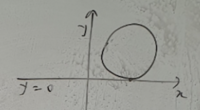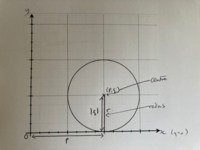I guess the question is:
The circle with equation: [MATH]x^2+y^2-(5k-1)x+(4-2k)y=5k[/MATH] touches the [MATH]x[/MATH]-axis, (e.g.) as shown:

(i.e. the [MATH]x[/MATH]-axis is a tangent to the circle).
Find [MATH]k[/MATH].
The work then shows us that this is a circle with centre [MATH](p,q)[/MATH] and radius [MATH]r[/MATH], with:
[MATH]p=\frac{5k-1}{2},\ \ q=k-2,\ \ r^2=5k+\left(2-k\right)^2+\ \left(\frac{5k-1}{2}\right)^2[/MATH]
Now the little bit under the picture.
It is a fact that when [MATH]y=Kx+n[/MATH] is a tangent to a circle with centre [MATH](p,q)[/MATH] and radius [MATH]r[/MATH], then
[MATH]\boldsymbol{r^2\left(1+K^2\right)=\left(Kp-q+n\right)^2}[/MATH](lamentably a different [MATH]K[/MATH] from the [MATH]k[/MATH] used in the rest of the question)!
(It is an interesting question to prove this formula).
So in this case, since the equation of the tangent line (the [MATH]x[/MATH]-axis) is [MATH]y=0[/MATH], then [MATH]K=0[/MATH] and [MATH]n=0[/MATH].
Therefore the formula [MATH]\boldsymbol{r^2\left(1+K^2\right)=\left(Kp-q+n\right)^2}[/MATH] reduces to [MATH]\boldsymbol{r^2=q^2}[/MATH].
However as Dr.Peterson points out, it is obvious in this case that [MATH]r=|q|[/MATH] (and therefore [MATH]r^2=q^2[/MATH]) since the centre of the circle is at a height [MATH]|q|[/MATH] above or below the [MATH]x[/MATH]-axis and this is the radius of the circle:

Using [MATH]r^2=q^2[/MATH], the work gives [MATH]k[/MATH]=-1/5
 (i.e. the [MATH]x[/MATH]-axis is a tangent to the circle).
(i.e. the [MATH]x[/MATH]-axis is a tangent to the circle).
